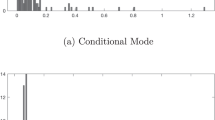Abstract
Heterogeneity among firms has been an important issue in studying firms’ technical efficiencies. If firms do not randomly fall into different groups with different technologies but by self-selection, statistically it implies the data are subject to the sample selection bias. In this paper, we generalize the stochastic frontier (SF) model to accommodate heterogeneous technologies among firms by considering the threshold SF model with an endogenous threshold variable. We discuss the econometric techniques appropriate for the threshold SF model with panel data. To determine the optimal number of regimes, we use modified the model selection criteria of Gonzalo and Pitarakis (J Econom 110(2):319–352, 2002) and investigate their finite sample performance by some Monte Carlo experiments. Finally, we also demonstrate our approach by an empirical example.
Similar content being viewed by others
Notes
Both assume the threshold variable is totally exogenous and does not depend on firms’ specific characteristics.
The same within transformation is also used in the estimation procedure xtreg of panel fixed effect model in the STATA programming software. Another transformation is \( s_{it}^{ * } = s_{it} - \bar{s}_{i} \), which gives the same estimation results, except that regression using the current transformation contains the intercept term. The STATA program using the transformation, \( \left( {s_{it} - \bar{s}_{i}^{j} } \right) \), is also available upon a request to the author.
Derivation of λ it can be found in the “Appendix”.
References
Alvarez A, del Corral J (2010) Identifying different technologies using a latent class model: extensive versus intensive dairy farms. Eur Rev Agric Econ 37(2):231–250
Amemiya T (1985) Advanced econometrics. Harvard University Press, Cambridge, MA
Bai J (1997) Estimating multiple breaks one at a time. Econom Theory 13(3):315–352
Bai J, Perron P (1998) Estimating and testing linear models with multiple structural changes. Econometrica 66(1):47–78
Chong TT-L (1994) Consistency of change-point estimators when the number of change-points in structural change models is underspecifed. Working paper, Chinese University of Hong Kong
Gonzalo J, Pitarakis J-Y (2002) Estimation and model selection based inference in single and multiple threshold models. J Econom 110(2):319–352
Greene W (2010) A stochastic frontier model with correction for sample selection. J Prod Anal 34(1):15–24
Hansen BE (1996) Inference when a nuisance parameter is not identified under the null hypothesis. Econometrica 64(2):413–430
Hansen BE (1999) Threshold effects in non-dynamic panels: estimation, testing, and inference. J Econom 93(2):345–368
Hansen BE (2000) Sample splitting and threshold estimation. Econometrica 68(3):575–603
Heckman J (1979) Sample selection bias as a specification error. Econometrica 47:153–161
Hirschman AO (1964) The paternity of an index. Am Econ Rev 54(5):761
Johnson NL, Kotz S, Balakrishnan N (1994) Continuous univariate distributions, vol 1, 2nd edn. Wiley, Hoboken, NJ
Kourtellos A, Stengos T, Tan CM (2009) Structural threshold regression. Working paper
Kumbhakar SC, Park BU, Simar L, Tsionas EG (2007) Nonparametric stochastic frontiers: a local maximum likelihood approach. J Econom 137(1):1–27
Kumbhakar SC, Tsionas E, Sipiläinen T (2009) Joint estimation of technology choice and technical efficiency: an application to organic and conventional dairy farming. J Prod Anal 31(3):151–161
Orea L, Kumbhakar SC (2004) Efficiency measurement using a latent class stochastic frontier model. Empir Econ 29(1):169–183
Pitarakis J-Y (2006) Model selection uncertainty and detection of threshold effects. Stud Nonlinear Dyn Econom 10(1):1–28
Pitt MM, Lee LF (1981) The measurement and sources of technical inefficiency in the Indonesian weaving industry. J Dev Econ 153:93–104
Schmidt P, Sickles RC (1984) Production frontiers and panel data. J Bus Econ Stat 2(4):367–374
Tsionas EG, Kumbhakar SC (2004) Markov switching stochastic frontier model. Econom J 7:398–425
Tsionas EG, Tran KC (2007) Bayesian inference in threshold stochastic frontier models. Working paper
Wang M-H, Huang T-H (2009) Threshold effects of financial status on the cost frontiers of financial institutions in nondynamic panels. Appl Econ 41:3389–3401
White H (1980) A heteroskedasticity-consistent covariance matrix estimator and a direct test for heteroskedasticity. Econometrica 48:817–830
Yélou C, Larue B, Tran KC (2010) Threshold effects in panel data stochastic frontier models of dairy production in Canada. Econ Model 27(3):641–647
Acknowledgments
Lai gratefully acknowledges the National Science Council of Taiwan (NSC 100-2410-H-194-059) for the research support. The author thanks an anonymous referee for helpful comments. The usual disclaimer applies.
Author information
Authors and Affiliations
Corresponding author
Appendix
Appendix
Given that υ it and e it follows a bivariate normal distribution with correlation coefficient ρ j under regime j, we may written υ it as
where \( \varepsilon_{it} = \kappa_{j} \left[ {e_{it} - {\text{E}}\left( {e_{it} |\gamma_{j - 1} - \pi^{\text{T}} z_{it} < e_{it} \le \gamma_{j} - \pi^{\text{T}} z_{it} } \right)} \right] + \xi {}_{it} \) and j = 1, …, m + 1. Then it follows from p. 156 of Johnson et al. (1994) that
Rights and permissions
About this article
Cite this article
Lai, Hp. Estimation of the threshold stochastic frontier model in the presence of an endogenous sample split variable. J Prod Anal 40, 227–237 (2013). https://doi.org/10.1007/s11123-012-0319-6
Published:
Issue Date:
DOI: https://doi.org/10.1007/s11123-012-0319-6




